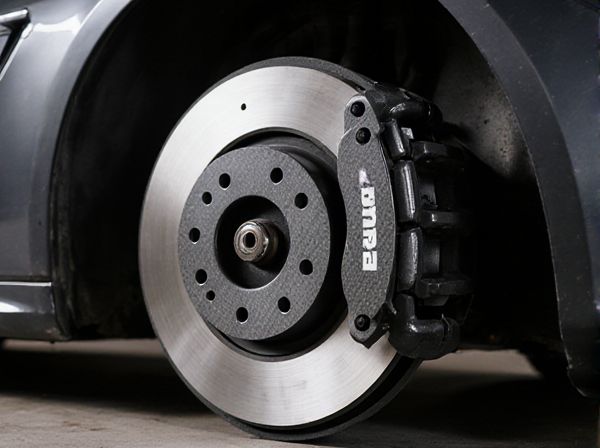
Photo illustration: Carbon Ceramic Rotors vs Steel Rotors
Carbon ceramic rotors offer superior heat resistance and reduced weight compared to steel rotors, enhancing braking performance and vehicle handling. These rotors provide longer lifespan and better fade resistance under extreme conditions, making them ideal for high-performance and track driving. Your choice depends on whether you prioritize durability and performance or cost-effectiveness and ease of maintenance.
Table of Comparison
| Feature | Carbon Ceramic Rotors | Steel Rotors |
|---|---|---|
| Material | Carbon fiber and ceramic composite | High-grade steel alloy |
| Weight | Lightweight, reduces unsprung mass | Heavier, increases unsprung mass |
| Heat Resistance | High heat tolerance, minimal brake fade | Moderate heat tolerance, prone to fade |
| Durability | Long lifespan, corrosion-resistant | Shorter lifespan, susceptible to rust |
| Performance | Superior stopping power, consistent under extreme conditions | Good stopping power, less consistent under high stress |
| Cost | High upfront cost | Affordable and widely available |
| Maintenance | Low maintenance, requires specialist service | Easy maintenance, common service procedures |
| Ideal Use | High-performance and luxury vehicles, racing | Daily driving, budget vehicles |
Introduction to Brake Rotor Materials
Carbon ceramic rotors offer superior heat resistance and reduced weight compared to traditional steel rotors, enhancing braking performance in high-performance and racing vehicles. Steel rotors provide excellent durability and cost-effectiveness, making them the standard choice for everyday driving applications. The material composition directly impacts heat dissipation, wear resistance, and overall braking efficiency in various driving conditions.
What Are Carbon Ceramic Rotors?
Carbon ceramic rotors are high-performance brake discs made from a composite material combining carbon fibers and ceramic matrix, designed to offer exceptional heat resistance and lightweight properties. These rotors provide superior braking performance, reduced fade, and increased longevity compared to traditional steel rotors. Commonly used in high-end sports cars and racing applications, carbon ceramic rotors deliver enhanced durability and improved thermal stability under extreme driving conditions.
What Are Steel Rotors?
Steel rotors are automotive brake components made from high-strength cast iron or steel alloys, known for their durability and cost-effectiveness. They offer reliable heat dissipation and consistent braking performance under typical driving conditions, making them standard in most vehicles. Despite being heavier than carbon ceramic rotors, steel rotors are easier to manufacture and maintain, contributing to their widespread use in everyday and performance cars.
Performance Differences: Carbon Ceramic vs Steel
Carbon ceramic rotors offer superior heat dissipation and reduced brake fade compared to steel rotors, making them ideal for high-performance and track driving. They are significantly lighter, which enhances handling and reduces unsprung weight, improving overall vehicle dynamics. Steel rotors provide durability and cost-effectiveness but typically suffer from faster wear and reduced thermal performance under extreme conditions.
Durability and Longevity Comparison
Carbon ceramic rotors offer significantly greater durability and longevity compared to steel rotors, with a lifespan often exceeding 100,000 miles under normal driving conditions. These rotors exhibit exceptional resistance to thermal degradation and wear, maintaining braking performance even under extreme temperatures. Steel rotors tend to wear faster due to heat-induced warping and corrosion, typically requiring replacement after 30,000 to 70,000 miles depending on driving habits.
Weight Considerations and Impact on Handling
Carbon ceramic rotors offer a significant weight reduction compared to steel rotors, often weighing up to 50% less, which decreases unsprung mass and rotational inertia. This reduction enhances vehicle responsiveness, improves suspension performance, and provides sharper handling characteristics during cornering. Lighter rotors help maintain tire contact with the road surface, resulting in superior traction and overall driving precision.
Cost Analysis: Carbon Ceramic vs Steel Rotors
Carbon ceramic rotors typically cost 3 to 5 times more than steel rotors, with prices ranging from $2,000 to $4,000 per set compared to $400 to $800 for steel counterparts. Despite the higher initial investment, carbon ceramic rotors offer significantly longer lifespan, often exceeding 100,000 miles, reducing replacement frequency and long-term maintenance expenses. Steel rotors, although more affordable upfront, require more frequent replacement and are prone to faster wear under high-performance conditions, increasing overall cost of ownership.
Maintenance Requirements and Lifespan
Carbon ceramic rotors offer significantly longer lifespan compared to steel rotors, often lasting up to 100,000 miles due to their resistance to heat and wear. Maintenance requirements for carbon ceramic rotors are minimal, as they are less prone to warping and corrosion, reducing the need for frequent inspections and replacements. In contrast, steel rotors typically require more frequent maintenance, including resurfacing or replacement every 30,000 to 70,000 miles, due to their susceptibility to rust and thermal degradation.
Best Applications for Each Rotor Type
Carbon ceramic rotors excel in high-performance and racing applications due to their superior heat resistance, reduced weight, and enhanced stopping power under extreme conditions. Steel rotors are best suited for everyday driving, off-road use, and heavy-duty vehicles because of their durability, cost-effectiveness, and consistent performance in moderate temperature ranges. Choosing carbon ceramic rotors benefits sports cars and track vehicles, while steel rotors provide reliable braking for commuter cars, trucks, and SUVs.
Choosing the Right Rotor for Your Vehicle
Carbon ceramic rotors offer superior heat dissipation, reduced weight, and longer lifespan compared to steel rotors, making them ideal for high-performance and track vehicles. Steel rotors provide reliable braking performance at a lower cost and are better suited for daily driving and general use. Selecting the right rotor depends on your driving style, budget, and vehicle requirements, with carbon ceramic rotors favoring performance enthusiasts and steel rotors meeting everyday needs.
 caratoz.com
caratoz.com